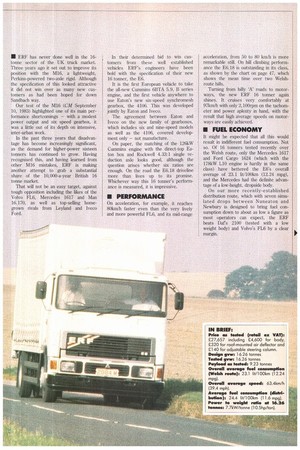BETTING ON A NEW MARKET
Page 46

Page 47

If you've noticed an error in this article please click here to report it so we can fix it.
With the E6.18 ERF is making its most determined effort to date to grab a major share of the lucrative 16-tonne UK market
• ERF has never done well in the 16tonne sector of the UK truck market. Three years ago it set out to improve its position with the M16, a lightweight, Perkins-powered two-axle rigid. Although the specification of this looked attractive it did not win over as many new customers as had been hoped for down Sandbach way.
Our test of the M16 (CM September 10, 1983) highlighted one of its main performance shortcomings — with a modest power output and six speed gearbox, it was a little out of its depth on intensive, inter-urban work.
In the past three years that disadvantage has become increasingly significant, as the demand for higher-power sixteen tonners has continued to grow. Having recognised this, and having learned from other MI6 mistakes, ERF is making another attempt to grab a substantial share of the 10,000-a-year British 16 tonne market.
That will not be an easy target, against tough opposition including the likes of the Volvo FL6, Mercedes 1617 and Man 16.170, as well as top-selling homegrown rivals from Leyland and lveco Ford. In their determined bid to win customers from these well established vehicles ER F's engineers have been bold with the specification of their new 16 tanner, the E6.
It is the first European vehicle to take the all-new Cummins 6BTA 5.9, B series engine, and the first vehicle anywhere to use Eaton's new six-speed synchromesh gearbox, the 4106. This was developed jointly by Eaton and Iveco.
The agreement between Eaton and Iveco on the new family of gearboxes, which includes six and nine-speed models as welt as the 4106, covered development only — not manufacture.
On paper, the matching of the 126kW Cummins engine with the direct-top Eaton box and Rockwell 4.33:1 single reduction axle looks good, although the question arises whether six ratios are enough. On the road the E6.18 driveline more than lives up to its promise. Whichever way this 16 tonner's performance is measured, it is impressive.
MI PERFORMANCE
On acceleration, for example, it reaches 80Icrn/h faster even than the very lively and more powerful FL6, and its mid-range acceleration, from 50 to 80 km/h is more remarkable still. On hill climbing performance the E6.18 is outstanding in its class, as shown by the chart on page 47, which shows the mean time over two Welshroute hills.
Turning from hilly 'A' roads to motorways, the new ERF 16 tonner again shines. It cruises very comfortably at 97km/h with only 2,100rpm on the tachometer and power aplenty in hand, with the result that high average speeds on motorways are easily achieved.
• FUEL ECONOMY
It might be expected that all this would result in indifferent fuel consumption. Not so. Of 16 tonners tested recently over the Welsh route, only the Mercedes 1617 and Ford Cargo 1624 (which with the 178kW L10 engine is hardly in the same class) have bettered the E6's overall average of 23.1 lit/100km (12.24 mpg), and the Mercedes had the definite advantage of a low-height, dropside body.
On our more recently-established distribution route, which with seven simulated drops between Nuneaton and Newbury is designed to bring fuel consumption down to about as low a figure as most operators can expect, the ERF beats Dafs 2100 (tested with a low weight body) and Volvo's FL6 by a clear margin.




















































































